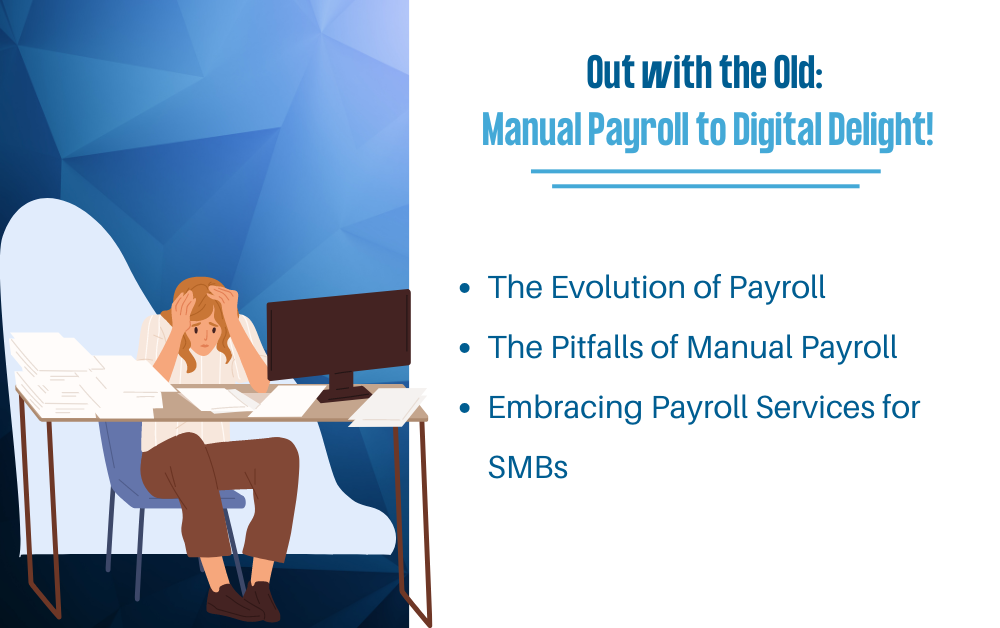blogs
Small Business Payroll: Focus on Growth, Leave Payroll to Us
Running a small business comes with a multitude of responsibilities, and payroll management can...
Biweekly Payroll: A Practical Solution For A Small Business
Managing payroll efficiently is crucial for any small business. One popular payroll schedule...
How Technology is Revolutionizing Payroll Processing
In today's fast-paced business world, payroll processing plays a crucial role in ensuring accurate...

Out with the Old: Manual Payroll to Digital Delight!
Are you tired of drowning in spreadsheets and paperwork just to pay your employees? It’s time to cut through the chaos and embrace a better way forward. Say goodbye to the inefficiencies of manual payroll and hello to the streamlined simplicity of modern payroll services. Let’s dive straight into the heart of the matter and explore why it’s time to upgrade your payroll game.
The Evolution of Payroll
From Bookkeeping to Digitalization
In the records of business history, payroll management traces back to the ancient art of bookkeeping. Medieval scribes meticulously recorded transactions by hand, balancing ledgers with painstaking precision. However, as industries burgeoned during the industrial revolution, the demand for more efficient methods grew. Mechanical calculators and punch card systems emerged, marking a significant step forward in payroll processing.
Yet, it wasn’t until the digital revolution of the late 20th century that payroll management truly transformed. Computers and software programs revolutionized the landscape, replacing manual processes with streamlined automation. Spreadsheets replaced ledger books, and calculations that once took hours now completed in minutes. Today, we stand at the forefront of a digital renaissance, where online platforms and mobile apps offer businesses unparalleled flexibility and efficiency in managing payroll.
This shift from manual bookkeeping to digitalization represents more than mere technological progress. It signifies a fundamental change in how businesses approach financial management. By embracing digital tools and automation, businesses unlock newfound efficiency and accuracy, leaving behind the limitations of manual payroll for a future defined by innovation and progress.
Embracing Digital Efficiency
In the digital era, manual payroll has become synonymous with inefficiency. Gone are the days of laborious data entry and endless calculations. With the advent of payroll services, businesses can now automate their payroll processes with ease. From direct deposit to automated tax calculations, modern payroll solutions have revolutionized the way businesses manage their finances.
As we bid farewell to the era of manual payroll, it’s essential to embrace the technological advancements that have paved the way for more efficient payroll management. By harnessing the power of payroll services, businesses can streamline their operations and focus on what truly matters—driving growth and success.
The Pitfalls of Manual Payroll
The Hassles and Headaches
Are you still grappling with the hassles and headaches of manual payroll processing? It’s time to shine a light on the pitfalls of sticking with outdated methods.
Manual payroll is a time-consuming endeavor that can drain valuable resources from your business. From manually inputting employee data to calculating taxes by hand, the process is riddled with opportunities for error. Even the most meticulous bookkeeper is susceptible to mistakes, which can lead to costly repercussions for your business.
Compliance Risks
In addition to the time-consuming nature of manual payroll, there are also significant compliance risks to consider. With tax laws and regulations constantly evolving, it’s easy to fall behind and inadvertently violate compliance standards. Whether it’s failing to accurately calculate taxes or overlooking changes in labor laws, the consequences of non-compliance can be severe.
By relying on manual payroll processes, businesses are putting themselves at risk of audits, fines, and legal headaches. It’s a risky game to play in today’s regulatory landscape, where even minor errors can have major ramifications. It’s time to acknowledge the shortcomings of manual payroll and explore a better alternative.
Embracing Payroll Services for SMBs
Unlocking Efficiency with BCM Payroll Services
Are you ready to break free from the shackles of manual payroll and unlock a world of efficiency? Let’s explore the benefits of outsourcing your payroll needs to BCM Payroll Services.
With BCM Payroll Services, small and medium-sized businesses (SMBs) can say goodbye to the headaches of manual payroll processing. Our comprehensive suite of services ensures that your payroll needs are taken care of efficiently and accurately, allowing you to focus on growing your business.
From guaranteed on-time payroll tax deposits to quarterly tax returns and year-end reconciliation, BCM Payroll Services has you covered every step of the way. Say goodbye to the stress of compliance and hello to peace of mind knowing that your payroll is in capable hands.
Focus on Growth
By outsourcing your payroll needs to BCM Payroll Services, you can redirect your time and resources towards what really matters—growing your business. Instead of getting bogged down by payroll administration tasks, you can focus on strategic initiatives that drive growth and success.
With BCM Payroll Services by your side, you can streamline your operations, reduce administrative burden, and unlock new opportunities for expansion. It’s time to embrace the future of payroll management and take your business to new heights with BCM Payroll Services.
Say Hello to Hassle-Free Payroll Management
As we reflect on the evolution of payroll—from manual bookkeeping to modernized payroll services—it’s clear that the time for change has arrived. The pitfalls of manual payroll are undeniable, from the time-consuming processes to the compliance risks that loom over every calculation. However, there’s a silver lining in the form of payroll services for SMBs.
By embracing BCM Payroll Services, businesses can bid farewell to the inefficiencies of manual payroll and unlock a world of efficiency and growth. With guaranteed on-time tax deposits, comprehensive payroll solutions, and a dedicated team of experts by your side, the possibilities are endless. Say goodbye to the headaches of payroll administration and hello to hassle-free payroll management with BCM Payroll Services.
Streamline Your Payroll Today
Ready to revolutionize your payroll process and take your business to new heights? Contact BCM Payroll Services today to learn more about our tailored solutions for SMBs. Say goodbye to manual payroll and hello to efficiency, accuracy, and peace of mind. Let’s embark on this journey together and unlock the full potential of your business.
